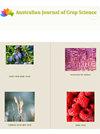Characteristics of two Panicum maximum grass cultivars fertilized with ash from wood grown in tropical soils
Q3 Agricultural and Biological Sciences
引用次数: 0
Abstract
It is estimated that the livestock sector accounts for about 40% of the value of global agricultural production. Livestock plays an essential role in maintaining food security as the sector contributes around 13% of calories and 28% of protein demands required by humans worldwide. Fertilization of tropical pastures with wood ash emerges as a sustainable practice that can contribute to better nutrient cycling, increased production, and reduced dependence on mineral resources. In this context, the aim of this study was to evaluate the production characteristics of two Panicum maximum grass cultivars fertilized with ash from wood grown in tropical soils of the Brazilian Cerrado. The experimental design was in randomized blocks in a factorial arrangement 5x2 with five doses of wood ash (0, 8, 16, 24, and 32 g kg-1) and two cultivars of Panicum maximum (cv. BRS Zuri and cv. Mombasa), with six replications. The experiment was carried out in 5 dm3 pots for 120 days. The wood ash used in the experiment comes from the combustion of eucalyptus (Eucalyptus sp.) logs in a boiler. The application of wood ash in acidic tropical soils increased leaf area, tillering, leaf dry mass, stem dry mass, and root volume in Mombasa and BRS Zuri cultivars of Panicum maximum grass, with maximum production at a dose of 32 g kg-1. The application of wood ash in acidic tropical soils offers potential as a sustainable strategy to increase production in forage production area for animal consumption in grazing, given the growing demand for beef. In addition, it properly and safely disposes of waste and recycles nutrients extracted by the crops.用热带土壤中生长的木材灰分施肥的两种大茴香草品种的特性
据估计,畜牧业约占全球农业产值的40%。牲畜在维持粮食安全方面发挥着至关重要的作用,因为该部门提供了全世界人类所需热量的13%和蛋白质需求的28%。利用木灰对热带牧场进行施肥是一种可持续的做法,有助于改善养分循环,提高产量,减少对矿产资源的依赖。在这种情况下,本研究的目的是评估两种最大的Panicum草品种的生产特性,这些品种用巴西塞拉多热带土壤中生长的木材灰施肥。试验设计采用5 × 2因子随机区组,分别添加5个剂量的木灰(0、8、16、24和32 g kg-1)和2个品种的大茴香(cv。BRS Zuri和cv。蒙巴萨),重复了6次。试验在5 dm3的盆栽中进行,为期120 d。实验中使用的木灰来自桉树(eucalyptus sp.)原木在锅炉中的燃烧。在热带酸性土壤中施用木灰可增加蒙巴萨和BRS Zuri品种的叶面积、分蘖、叶干质量、茎干质量和根体积,在32 g kg-1剂量下产量最大。鉴于对牛肉的需求不断增长,在酸性热带土壤中应用木灰作为一种可持续战略,有可能增加饲料生产区的产量,以供放牧动物消费。此外,它妥善和安全地处理废物和回收作物提取的营养物质。
本文章由计算机程序翻译,如有差异,请以英文原文为准。
求助全文
约1分钟内获得全文
求助全文
来源期刊

Australian Journal of Crop Science
农林科学-农艺学
CiteScore
1.20
自引率
0.00%
发文量
75
审稿时长
3.5 months
期刊介绍:
Information not localized
 求助内容:
求助内容: 应助结果提醒方式:
应助结果提醒方式:


